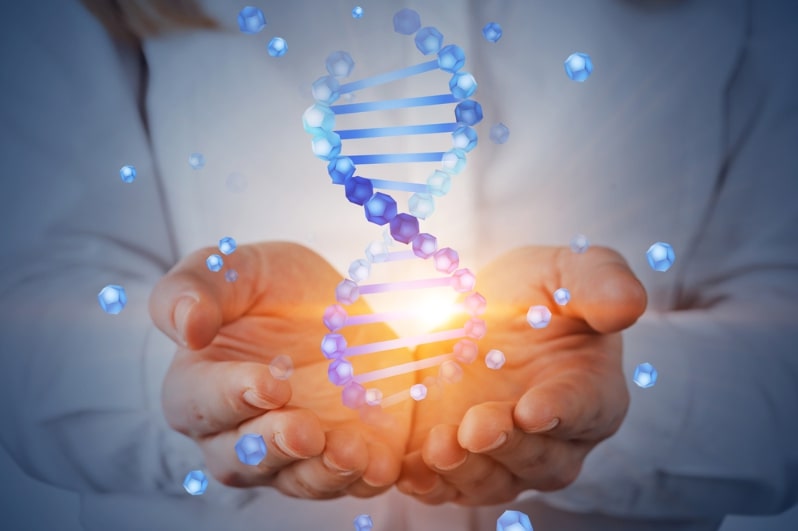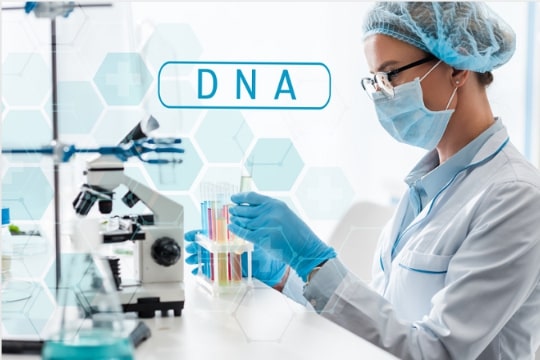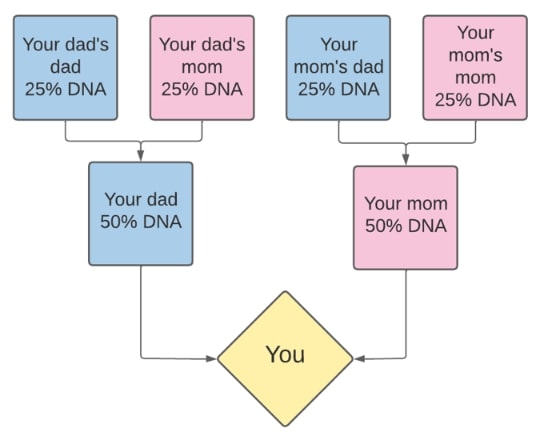Introduction: In this article, Katie Rebecca Garner explains how much DNA we inherit from our ancestors – and how much we share with siblings and other relatives. Katie specializes in U.S. research for family history, enjoys writing and researching, and is developing curricula for teaching children genealogy.
When you take a DNA test and view your matches, you might wonder how everyone is related to you. Many databases will indicate the amount of DNA you share with each match, and some of these will include relationship estimates.
The less DNA shared between you and a match, the more possible estimated relationships will be listed. The more distant the relationship, the higher the chance of confusion if you don’t understand how DNA inheritance works. This article will illustrate various relationships which could share DNA.

Photo credit: https://depositphotos.com/home.html
Cousins share DNA because they inherited the same DNA from the same common ancestor(s). Before we can explore this, let’s look at DNA shared between you and your parents and grandparents.
When a baby is conceived, they receive half their DNA from their mother and half from their father. The half which comes from each parent is random. Each of your parents received half their DNA from each of their parents. Likewise, you received half of your DNA from each of your parents. In this manner, approximately one quarter of your DNA came from each of your grandparents, as shown in the chart below.
Note: All the charts in this article were created by the author.
When a couple has multiple children, each child receives a different half of the parents’ DNA at random. Each of the children (full siblings) will share approximately half (50%) their DNA with each other. That much shared DNA is evident in the amount of resemblance families typically have with each other. Half siblings share about half the amount of DNA as full siblings because they inherited the same DNA from one parent rather than two.
In the chart below, Purple had three kids with Blue and two kids with Red. All five kids inherited DNA from Purple. By examining the chart, you can see the similarities between the kids of the Blue-Purple union and the kids of the Purple-Red union. Children of these kids would be half cousins.
When mortality rates were higher, many of our ancestors were widowed, sometimes at a young age. Back then society was not as friendly for single people as it is today, so many widows and widowers had to remarry for financial reasons. A widow or widower remarrying while still young enough to have kids could have had kids with more than one spouse.
This custom means there could be half siblings and half cousins anywhere on your family tree. In more recent times, divorce and remarriage leads to ancestors or relatives having half siblings and half cousins. Illegitimacy can bring about unknown half siblings.
Where there are customs of remarriage, there are also blended families with stepsiblings and stepchildren. Step relatives would not share DNA with each other. Adopted children would share DNA with their biological parents rather than their adopted parents. While these non-biological relationships would have mattered to our ancestors, they are relationships not covered by DNA testing.
Now that we’ve looked at parents and children and siblings, let’s expand that to include grandparents, cousins, aunts, and uncles. For the remaining discussion, we will only be looking at full relationships to keep the demonstrations simple.
As previously discussed, you inherited about a quarter (25%) of your DNA from your grandparents. Your cousins by those same grandparents also received 25% of their DNA from them. This means you and your cousins share on average one eighth (12.5%) of your DNA.
This is an average because of the randomness of DNA inheritance. With one cousin you could share 11% and another 13%. Because your parents and their siblings share about 50% of their DNA, 25% of your DNA would be identical to your aunts and uncles. Again, this is an average and could be more or less.
This inheritance pattern is illustrated on the chart below. Green and Pink got married, Blue and Purple got married, Navy and Yellow got married. Each couple had three children together. The next generation shows three sets of three siblings, each with different coloring to represent the DNA they inherited from their parents.
One of the children of the Blue-Purple union married a child from the Green-Pink union and another married a child from the Navy-Yellow union. Each of those couples had three children. That generation is portrayed with coloring to represent the DNA each child inherited from their parents and grandparents. Note that Blue and Purple are the common ancestors of the third generation, and each child in that generation has shared DNA from them. The differences between them are because they each inherited different DNA from their progenitors.
As cousins become more distant, the amount of DNA shared between them decreases. Additionally, the chance of sharing DNA with the cousins decreases. The DNA your father shares with his fourth cousin may not have been passed down to you but may have been passed down to your sibling.
As you get into distant cousins, you start to get into the “cousins removed” relationship, which causes confusion to many people. Removed refers to generational differences.
This is illustrated on the chart below, in which Paul and Hope are the common ancestors. The number (first, second, third) refers to how many generations between them and the common ancestor. John and Bob are siblings; their parents are their common ancestors. Their children, Susan and Jane, are first cousins. Paul and Hope are their grandparents. Peter and Anna, great-grandchildren of Paul and Hope, are second cousins. Jonny and Andrew are third cousins, since they are both great-great-grandchildren of the same ancestors. Mary and Patrick are third-great-grandchildren of Paul and Hope; they are fourth cousins.
If the common ancestor is of a different generation from the cousins, that’s where the removed comes in. If you look at the chart below, you will see that Jonny and Jane are first cousins twice removed. Their common ancestors are Jane’s grandparents and Jonny’s great-great-grandparents. Jonny’s grandmother is Jane’s first cousin.
Peter and Andrew are second cousins once removed; their common ancestors are Peter’s great grandparents and Andrew’s great-great grandparents. Andrew’s mother is Peter’s second cousin. Jonny and Patrick are third cousins once removed; their common ancestors are Jonny’s second-great and Patrick’s third-great grandparents. Patrick’s father is Jonny’s third cousin.
If your ancestor had half siblings, you would have half distant cousins. This is shown on DNA Painter’s more comprehensive cousin chart.
Understanding how relationships work can help you determine how you’re related to your genetic cousins. You inherited DNA from the same ancestor(s). Keep an eye out for other articles on DNA to learn how this knowledge can help you in your research.
Explore over 330 years of newspapers and historical records in GenealogyBank. Discover your family story! Start a 7-Day Free Trial
Note on the header image: DNA testing. Credit: https://depositphotos.com/home.html
Related Article:

